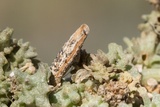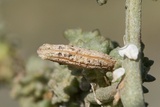Coleophora adspersella Benander, 1939 Species
Last modified: Dec. 2, 2024, 5:38 p.m.
A very rare and local species in Belgium. Hitherto, it is only found at the coast where it can be abundant at suitable places and recently (2020) in LI and (2022) in OV and LG.
Details
- Classification
- Family: Coleophoridae > Genus: Coleophora > Species: Coleophora adspersella
- Vernacular names
- Witsprietmeldekokermot (NL), Dusted case-bearer (EN), Helle Melden-Sackmotte (DE)
- First mention in Belgium
- De Prins W. & Spronck R. 2004. Four new species for the Belgian fauna (Lepidoptera: Gracillariidae, Coleophoridae and Tortricidae). — Phegea 32(2): 49–54. On page 50. view page
- Status
-
Native
Distribution
Imago
Wingspan 13–16 mm.
A light brown moth with a lot of dark speckles.
The antennae are ringed with alternating white and light brown segments.
Museum specimens
No pictures yet!Specimens in nature
No pictures yet!Caterpillar
The caterpillar is greenish with some dark spots on the thoracic segments and the last abdominal segment.
Case
The silken case is about 10 mm long, trivalved, tubular and with a mouth angle of 0°–10°.
See also bladmineerders.be.
Bionomics
The egg is oviposited during summer on the food plant.
The caterpillar spins a case within its life, feeds, and pupates. The larva leaves the food plant by the end of August, overwinters in leaf litter at ground level, and pupates there in springtime.
Flight periods
The moths are on the wing from the end of May till the beginning of August.
Observed on
- Host plant (species):
- Atriplex littoralis and Suaeda maritima
- Host plant (genera):
- Atriplex, Chenopodium, Suaeda, Halimione and Beta
Atriplex littoralis is the most often infested host plant, but also species of Atriplex, Beta, Chenopodium, Halimione or Suaeda are used.
Habitat
This species is mainly found at the coast where the food plants are most common.


